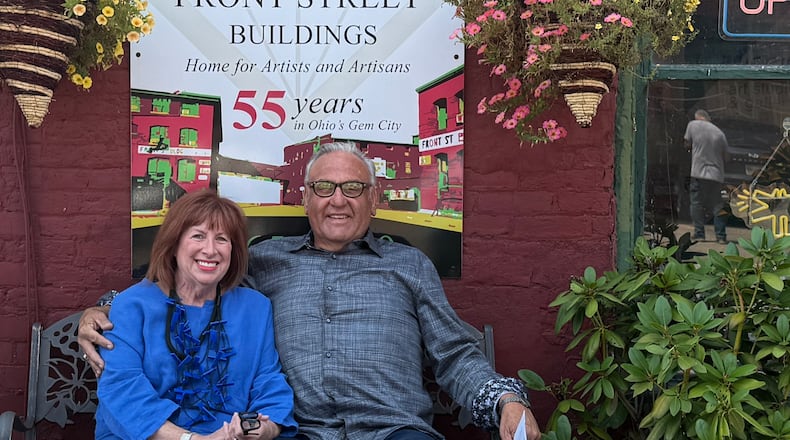It was 10 years ago that the Chicago real estate broker was asked by a Dayton friend to visit his funky art complex on the outskirts of downtown Dayton and to make suggestions about its future and viability. Zimmel Miller and his wife had owned the property since 1965.
“Living in Dayton was never on my radar,” said Lundin. He and his wife, Carol, always figured they’d move somewhere south after retirement.
But after spending a week touring the Front Street buildings, a fired-up Lundin excitedly called his wife. He loved the three old structures, the architecture.
“Dayton’s a fixer-upper,” he told her. “Front Street isn’t realizing its potential.”
At that time many of the buildings were being used for storage and though it was officially prohibited, some people were living in their studio spaces.
“It was my vision to turn storage spaces into additional artist studios, add more small businesses,” Lundin said. “I wanted it to become a regional center, a destination.”
Today, Richard is not only Front Street’s property manager, but a co-owner, along with his wife and Zimmel Miller’s two Chicago daughters. The Lundins are proud to call Centerville home and the historic complex they’ve come to love is preparing to strut its stuff at a 60th Anniversary Bash.
Slated for Saturday, Sept. 6, the party will take on a ’60s vibe with open studios, a beer garden, entertainment a food truck rally and a retro JELL-O salad competition.
How things have changed
Thanks to the Lundins, there’s now a wait list for Front Street rentals and 200 artists and artisans are occupying the 225,000 square foot campus. There are working art studios, art galleries and small businesses including a movement studio, antique and vintage shops and a place to grab a cup of coffee or sandwich. Available services now include furniture repair, upholstery, textile design, architectural salvage a hair salon and a gym. There’s a sound bath and Reiki treatments and many artists now offer classes.
There’s an open door policy from 7 a.m. to 7 p.m. seven days a week. Though the artists determine their own hours, visitors will typically find a number of studio and shop doors open at any given time.
The Lundins have continued to add special touches. A pollinator garden attracts butterflies and bees; there’s an aquarium in Richard’s office.
“It’s like a whole new place,” said artist Scott Gibbs, who’s been renting studio space at Front Street since 1998 and had been toying with the idea of moving when the Lundins came to town. He’s glad he decided to stay.
“The past 10 years have been the most active time here,” Gibbs said. “Carol and Richard are sincere, genuine big city people and they’ve made this a mecca of creative endeavors. They are genuine patrons of the arts.”
Photographer Bruce Soifer has been at Front Street for a year.
What he appreciates most, he said, is the exchange of ideas with other artists and working in a creative community.
Monthly Art Hops now occur on the first Friday and Saturday of each month and Front Street also hosts three major events--Artebration, The Great Food Truck Rally and a Christkindl Market.
Reaching out to the community
Richard is described as a hands-on manager who encourages interaction among his tenants. Carol is Front Street’s effervescent “front man,” networking in the community and making new friends. Carol is the board chair of the Levitt Pavilion where the couple sponsors a concert each summer.
Madeline Hart, director of marketing and communication for the Levitt, believes the Lundins have been instrumental in shaping the cultural landscape of our city through their dedication to the arts.
“Together, the Lundins have invested both financially and emotionally in nurturing Dayton’s artistic spirit,” said Hart. “Their efforts have not only preserved the creative energy of spaces like Front Street but have also extended to public art initiatives.
Tracey Tomme, President and CEO of the Dayton Society of Natural History, said the Lundins are the first to offer help with projects and are great connectors.
" I can’t even list how many opportunities and individuals I have met through them,“ Tomme said. ”During the eclipse they cooked up an amazing amount of food for our guests at SunWatch. They brought it, served it, cleaned up, and were absolutely charming the entire time. When we needed a large cement tree limb removed from the Rain Forest habitat at the Boonshoft Museum, Richard jumped right in. He found a few people to help and moved literally over a ton of cement one little load at a time out of enclosure and then prepped out a new sleeping area in the tree trunk for Patience, our sloth.”
When the museum decided to add naked mole rats, Richard helped design and build the exhibit connecting the museum with glass artists from Front Street.
“Richard helped us create the new burrowing owl exhibit to make it bigger even while he had a lot going on. He is never too busy, never too tired. He is an amazing problem solver and isn’t afraid to get in there and do the work himself.”
The Lundins are also active at Wright State University. Their foundation, Front Street Global Artists Initiative, sponsors the Wright State Arts Gala, has funded numerous scholarships, internships, and other initiatives for students across multiple areas of the college. Carol serves on the CoLA Dean’s Leadership Board, which advises the dean on questions of how to align curricular objectives with skills and competencies in high demand in the job market.
“Front Street has provided an invaluable forum for Wright State Students and alumni to exhibit their artwork, hone entrepreneurial and management skills, and network with artists and leaders in the community,” said Gary Schmidt, Dean of the College of Liberal Arts.
Tomme and her husband love going to Front Street to meet people, buy art, visit the food trucks and relax with friends.
“It’s a great place to buy holiday gifts. You can find so many unusual items there from jewelry to paintings to ceramic,” she said. “You can meet the artists and often even see them working, talk about their inspirations and challenges, and learn from them.
“We have commissioned pieces for our home multiple times. That may sound expensive but you’d be surprised at the value and affordability when you actually talk to the artists. I never knew we had such talented artists in Dayton.”
FRONT STREET’S HISTORY
- During the 1850s, the street now called Front Street was originally a waterway, part of a canal 200 miles long, generating power and being the manufacturing hub of Dayton.
- The red brick buildings located at Second and Front streets are the original Mead Paper Factory that opened in 1856.
- The two blocks of Front Street from Third Street running to the railroad tracks not only housed Mead paper but also the Davis Sewing Machine, Aughe Plow Works and Lowe’s Brothers Paint, all operating during the 1850s.
- From 1907 through 1965, the buildings were home to Mercantile Corporation which manufactured envelops for the United States government. All envelopes used by the federal government were manufactured there, at its peak 18 million envelopes per day.
- During the 1980s and 1990s, Front Street was a mecca of skateboarding and home to Alien Skateboard which became the world’s largest skateboard company.
HOW TO GO
What: Front Street’s 60th Anniversary Bash
When: Saturday, Sept. 6
Details: An Art Hop will take place from 11 a.m. to 4 p.m.; a food trick rally from 5-9 p.m. From 6-7 p.m. Anna Marie, Gem City Folk Acoustic singer/songwriter will perform and from 7-9 p.m. Ohio Brass and Electric will take the stage
Where: 1001 E. Second St., Dayton
Cost: Free
Other: Front Street is regularly open from 7 a.m. to 7 p.m. seven days a week. Visit the website at frontstreet.art.
About the Author





